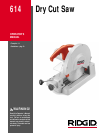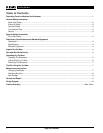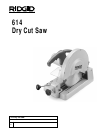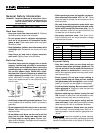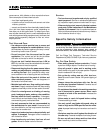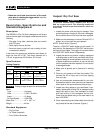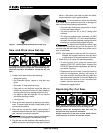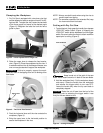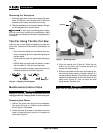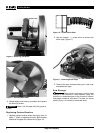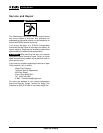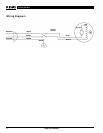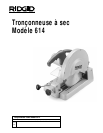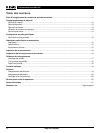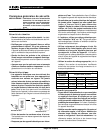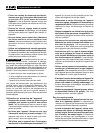
Ridge Tool Company
3
cause cancer, birth defects or other reproductive harm.
Some examples of these chemicals are:
• lead from lead-based paints
• crystalline silica from bricks and cement and other
masonry products
• arsenic and chromium from chemically-treated lumber
Your risk from these exposures varies, depending on
how often you do this type of work. To reduce your expo-
sure to these chemicals: work in a well ventilated area and
work with approved safety equipment such as those dust
masks that are specially designed to filter out micro-
scopic particles.
Tool Use and Care
• Use clamps or other practical way to secure and
support the workpiece to a stable platform. Holding
the workpiece by hand or against your body is unsta-
ble and may lead to loss of control.
• Do not force tool. Use the correct tool for your
application. The correct tool will do the job better
and safer at the rate for which it is designed.
• Do not use tool if switch does not turn it ON or
OFF. Any tool that cannot be controlled with the switch
is dangerous and must be repaired.
• Disconnect the plug from the power source before
making any adjustments, changing accessories,
or storing the tool. Such preventive safety mea-
sures reduce the risk of starting the tool accidentally.
• Store idle tools out of the reach of children and
other untrained persons. Tools are dangerous in
the hands of untrained users.
• Maintain tools with care. Keep cutting tools sharp
and clean. Properly maintained tools with sharp cutting
edges are less likely to bind and are easier to control.
• Check for misalignment or binding of moving
parts, breakage of parts, and any other condition
that may affect the tool's operation. If damaged,
have the tool serviced before using. Many accidents
are caused by poorly maintained tools.
• Use only accessories that are recommended by
the manufacturer for your model. Accessories that
may be suitable for one tool may become hazardous
when used on another tool.
• Inspect tool and extension cords periodically and
replace if damaged. Damaged cords increase the
risk of electrical shock.
• Keep handles dry and clean; free from oil and
grease. Allows for better control of the tool.
Service
• Tool service must be performed only by qualified
repair personnel. Service or maintenance performed
by unqualified repair personnel could result in injury.
• When servicing a tool, use only identical replace-
ment parts. Follow instructions in the Maintenance
Section of this manual. Use of unauthorized parts or
failure to follow maintenance instructions may create a
risk of electrical shock or injury.
Specific Safety Information
WARNING
Read this operator’s manual carefully before using
the 614 Dry Cut Saw. Failure to understand and fol-
low the contents of this manual may result in
electrical shock, fire and/or serious personal injury.
Call the Ridge Tool Company, Technical Service
Department at (800) 519-3456 if you have any questions.
Dry Cut Saw Safety
• Wear safety glasses and ear protection. Protects
eyes from foreign objects. Prevents loss of hearing.
• Keep all guards in place and in working order.
Never clamp or tie guard in the open position. Exposed
blade increases the risk of injury.
• Set up the dry cutting saw on a flat, level sur-
face. Be sure the saw is stable. Will prevent tipping of
the unit.
• Always clamp the workpiece with vise. Do not
perform any operation freehand. Prevents loss of
control of the workpiece.
• Do not place either hand in the working area when
tool is connected to power source. Never reach
around or in back of the saw blade. Increases the
risk of injury.
• Allow motor to reach full speed before cutting.
Prevents stalling of motor.
• Use only cut-off saw blade with speed rating at
least as high as the RPM specified on the name-
plate. Improper blade may be hazardous and result in
injury.
• Workpiece must be cut off against the direction of
the saw only. Prevents workpiece from being thrown.
• Be sure cut-off saw is sharp and free from vibra-
tion. Less likely to bind and lose control.
614 Dry Cut Saw



